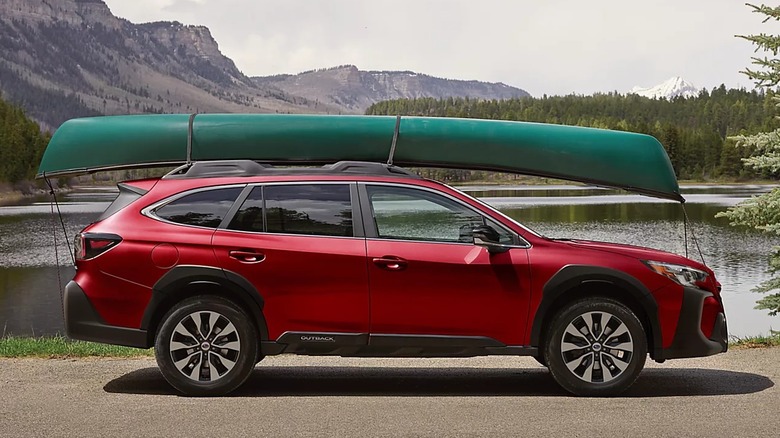When (And Why) Did Subaru Start Using CVT Transmissions?
Japanese automaker Subaru has a fairly extensive range of vehicles in the U.S. Among the more successful models sold by the company include the Subaru Crosstrek, the Forester, and the Subaru Outback. Other SUV models in the company's lineup include the Subaru Ascent and the all-electric Subaru Solterra. Besides these models, Subaru also makes cars (Subaru Impreza, Subaru Legacy), as well as performance-focused vehicles like the Subaru BRZ and the Subaru WRX. If you take a casual look at Subaru's U.S portfolio, particularly the transmission spec sheet of its cars, you'd notice a peculiar detail. Most vehicles in the company's U.S. portfolio use a Continuously Variable Transmission (CVT) transmission, which the company brands as the Lineartronic CVT.
Subaru has been offering this CVT as standard on most Subaru vehicles since 2014. As of 2025, the only exceptions to this are the two performance-focused cars in its lineup: the Subaru BRZ (6-speed manual or 6-speed automatic transmission), and the Subaru WRX (6-speed manual or an 8-speed automatic with manual mode). The company's all-electric offerings are also exempt, since EVs don't need a traditional transmission system.
The rest of Subaru's vehicles in the U.S. get various iterations of the company's Lineartronic CVT, with additional features like adaptive control, incline start assist, and low shift modes. Some of Subaru's CVT-toting cars also feature dedicated manual modes for those who prefer the manual control in their vehicles. While Subaru's first try with CVTs dates back to 1989 with the Subaru Justy, the first instance of the company using it on a fairly recent model dates back to 2010 when it announced the Lineartronic CVT.
Why did Subaru begin the switch to CVTs in 2010?
The first Subaru vehicle to feature the now-standard Lineartronic CVT was the 2010 Subaru Legacy. It took four more years for Subaru to bring the variants of the same transmission to its wider range. By 2014, most Subaru cars (with the exception of the BRZ) had the Lineartronic CVT transmission offered as standard after they found the transmission to be well-suited to Subaru's boxer engines. Subaru asserts that its shift to CVT primarily happened due to three main reasons: less transmission wear and tear, better linear acceleration and performance, and better fuel efficiency with lower emissions.
While automotive purists will likely smirk at CVTs in general, most of the claims made by Subaru are rooted in reality. CVTs do tend to have fewer moving parts compared to traditional gearboxes, and they aid in better fuel efficiency; which in turn leads to lower emissions. As far as Subaru's Lineartronic CVT is concerned, a major advantage it held over traditional CVTs was that it uses a chain for power transfer, as opposed to belts. Subaru asserts that this leads to better response and a more natural driving feel, while also making the CVT operate silently and efficiently.
Today, Subaru's Lineartronic CVT transmissions come with several additional features like adaptive control, incline start assist, low shift mode, and multiple (6-speed, 7-speed, and 8-speed) manual modes. It goes without saying that Subaru's decision to focus on its now-tried-and-tested Lineartronic CVT has proven to be a success. In fact, it might not be inaccurate to state that this move could have been one of the factors that helped the company stay fiercely independent in a world dominated by large automotive conglomerates.

